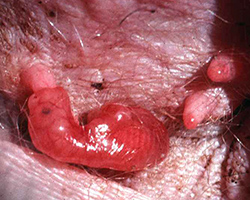Kangaroo Joeys

While kangaroos are known for their hops, they may be just as well known for their pouches. Kangaroos give birth to only partially developed young (after about a month of development). These tiny fetuses, about the size of a jelly bean, crawl up and into the mother’s pouch after they are born. There, they will latch on to a nipple, where they get milk from their mother, and develop in the pouch for about 4 months. Once they are big enough, they will finally start leaving the pouch for part of each day for the next 8 months or so.
When a joey grows to be too big for the pouch, its mother will constrict the entrance, to keep it from expanding. This makes it too difficult for the joey to re-enter the pouch, so the joey then learns to spend all of its time outside of the pouch.
Do All Kangaroos Have Pouches?
You’re at the zoo, staring at five kangaroos that are standing nearby… but you don’t see a single pouch on their bellies. Does that mean they’re all male?

It’s true that only female kangaroos have pouches, but just because you don’t see a pouch entrance doesn’t mean you’re looking at a male. Pouches can be really hard to see. The entrance to a pouch is usually small, so it stays hidden easily. But it is elastic and can stretch out quite a bit when a joey is trying to get into it.
Sometimes, you may see bigger joeys with just their heads or noses stuffed into the pouch. As joeys grow, even when they no longer stay in the pouch, they still nurse, drinking their mother’s milk until they are over a year old. As they get older, they will start to eat more plants and drink less milk, until they stop drinking milk altogether.
Read more about: Keeping up With Kangaroos
Bibliographic details:
- Article: Kangaroo Joeys
- Author(s): Dr. Biology
- Publisher: Arizona State University School of Life Sciences Ask A Biologist
- Site name: ASU - Ask A Biologist
- Date published:
- Date accessed:
- Link: https://askabiologist.asu.edu/kangaroo-joey
APA Style
Dr. Biology. (). Kangaroo Joeys. ASU - Ask A Biologist. Retrieved from https://askabiologist.asu.edu/kangaroo-joey
Chicago Manual of Style
Dr. Biology. "Kangaroo Joeys". ASU - Ask A Biologist. . https://askabiologist.asu.edu/kangaroo-joey
Dr. Biology. "Kangaroo Joeys". ASU - Ask A Biologist. . ASU - Ask A Biologist, Web. https://askabiologist.asu.edu/kangaroo-joey
MLA 2017 Style

A watercolor illustration of a mother kangaroo and her joey, by Sabine Deviche, from the children's book Joryn Looked Up.
Be Part of
Ask A Biologist
By volunteering, or simply sending us feedback on the site. Scientists, teachers, writers, illustrators, and translators are all important to the program. If you are interested in helping with the website we have a Volunteers page to get the process started.

